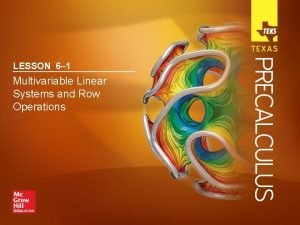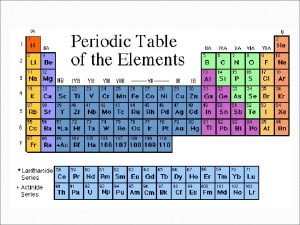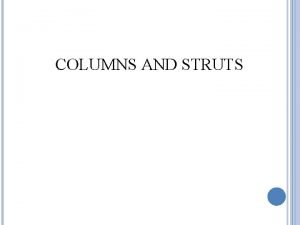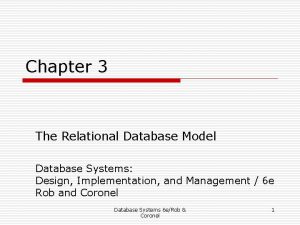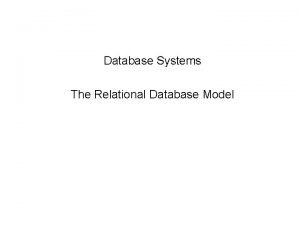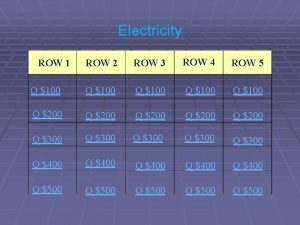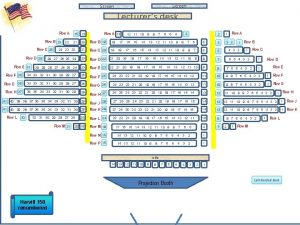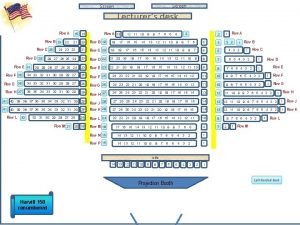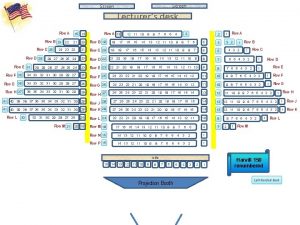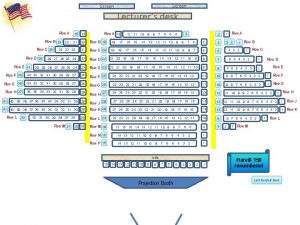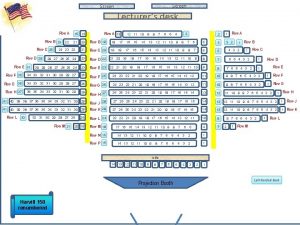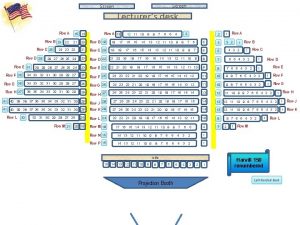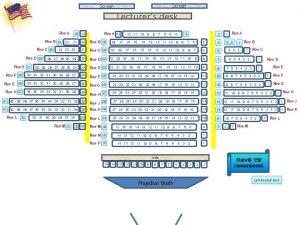Linear Spaces Row and Columns Spaces From D




















- Slides: 20

Linear Spaces Row and Columns Spaces From: D. A. Harville, Matrix Algebra from a Statistician’s Perspective, Springer. Chapter 4

Definitions - I • Column Space of mxn matrix A ≡ set of all m-dimensional column vectors that can be expressed as linear combinations of columns of A • Row Space of mxn matrix A ≡ set of all n-dimensional row vectors that can be expressed as linear combinations of rows of A

Definitions - II • Linear Spaces: A non-empty set V of matrices of the same dimensions is a linear space if: 1) For every A in V, and every B in V, A+B is in V 2) For every A in V, and every scalar k, k. A is in V 3) A 1, …, Ak in V and scalars x 1, …, xk x 1 A 1+…+xk. Ak is in V • Examples • • • Column space of any mxn matrix is a linear space of mx 1 vectors Set containing all mxn matrices is a linear space Set of all nxn symmetric matrices is a linear space (sums and scalar multiples) All linear spaces contain the null matrix of correct dimension {0} is a linear space with only the null matrix included

Notation • C(A) ≡ Column space of the matrix A • R(A) ≡ Row space of the matrix A • Rm n ≡ Linear space of all mxn matrices • Rn ≡ Linear space of all nx 1 column vectors (1 xn row vectors) • R(In) = Rn ≡ Linear space of all 1 xn row vectors • C(In) = Rn ≡ Linear space of all nx 1 column vectors • x S x is an element of S • x S x is not an element of S

2 Lemmas Involving Row/Column Spaces and Linear Spaces Lemma 4. 1. 1. For any matrix A, y C(A) if and only if y’ R(A’) y C(A) y = Ax for some x y’ = (Ax)’ = x’A’ y’ R(A’) y’ = x’A’ for some x (y’)’ = (x’A’)’ = Ax y C(A) Lemma 4. 1. 2. B ≡ mxn V ≡ Linear space of mxn matrices Then for any A V, A+B V iff B V If A V and B V, then A+B V by definition of a linear space If A V and A+B V then k 1 A + k 2(A+B) V by definition of a linear space. Let k 1 = -1, k 2 = 1 k 1 A + k 2(A+B) = B and thus B V

Subspaces • Subset U of a linear space V is termed a subspace of V if it is a linear space. • Trivial Cases: (1) The null set {0} and (2) the entire set V • Column space C(A) of mxn matrix A is a subspace of R m (set of all mdimensional vectors) • Row space R(A) of mxn matrix A is a subspace of R n (set of all ndimensional vectors) • For any 2 subsets, S and T of a given set (say 2 subspaces of R mxn), S is contained in T if all elements of S are elements of T (S T) • If S T and T S, then S = T

Results Involving Subspaces Lemma 4. 2. 1. A ≡ mxn Then for any subspaces U of R m and V of R n : C (A) U iff every column of A is in U, R (A) V iff every row of A is in V where A = [a 1 … an] If C (A) U then all ai U (Let xi = (0, …, 0, 1, 0, …, 0)’) If ai U i=1, …, n then y C (A) y = Ax y = x 1 a 1 + … + xnan and since U is linear space, y U Lemma 4. 2. 2. A ≡ mxn B ≡ mxp C ≡ qxn : C (B) C (A) iff there exists nxp F such that B = AF R (C) R (A) iff there exists qxm L such that C = LA Corollary 4. 2. 3. For any A ≡ mxn F ≡ nxp L ≡ qxm : C (AF) C (A) and R (LA) R (A) Corollary 4. 2. 4. A ≡ mxn E ≡ nxk F ≡ nxp L ≡ qxm T ≡ sxm : (1) If C (E) C (F) then C (AE) C (AF) and if C (E) = C (F) then C (AE) = C (AF) (2) If R (L) R (T) then R (LA) R (TA) and if R (L) = R (T) then R (LA) = R (TA) Lemma 4. 2. 5. A ≡ mxn B ≡ mxp : (1) C (A) C (B) iff R (A’) R (B’) (2) C (A) = C (B) iff R (A’) = R (B’) (1) A = BF A’ = (BF)’ = F’B’

Bases • Span of a finite set of matrices of common dimensions: • Finite nonempty set {A 1, …, Ak}: set of all matrices being linear combinations of {A 1, …, Ak} • Empty set: {0} (unique basis – see below for definition of basis) • Span of a finite set S of matrices written as sp(S) which is a linear space • sp({A 1, …, Ak}) ≡ sp(A 1, …, Ak) ≡ span of the set {A 1, …, Ak} • Finite set S of matrices in linear space V spans V if sp(S) = V • Basis for V is a finite linearly independent set of matrices in V that spans V • C(A) for A ≡ mxn is spanned by the set of its n columns. If lin. indep. basis • R(A) for A ≡ mxn is spanned by the set of its m rows. If lin. indep. basis • If the columns or rows of A are not linearly independent, they are not a basis

Natural Bases for R m n and Linear Space of nxn Symmetric Matrices

Results Involving a Basis - I Lemma 4. 3. 1. A 1, …, Ap and B 1, …, Bq in linear space V If {A 1, …, Ap} spans V, then so does {A 1, …, Ap, B 1, …, Bq} If {A 1, …, Ap, B 1, …, Bq} spans V and if B 1, …, Bq are linear functions of A 1, …, Ap then {A 1, …, Ap} spans V Theorem 4. 3. 2. V ≡ linear space spanned by a set of r matrices. Let S ≡ set of k lin. indep. Matrices in V Then k ≤ r and if k = r, then S is a basis for V Corollary 4. 3. 3. The number of matrices in a linearly independent set of m n matrices cannot exceed mn. Number of matrices in a linearly independent set of n n symmetric matrices cannot exceed n+n(n-1)/2 = n(n+1)/2 Theorem 4. 3. 4. Every linear space of m n matrices has a basis Lemma 4. 3. 5. Matrix A in linear space V can be written as a unique linear combination of matrices in any particular basis {A 1, …, Ak} with unique coefficients x 1, …, xk and A = x 1 A 1+…+xk. Ak

Results Involving a Basis - II Theorem 4. 3. 6. Any two bases of the same linear space V have the same number of matrices. The number of matrices in the basis is its dimension: dim(V) Theorem 4. 3. 7. If linear space V is spanned by set of r matrices, then dim(V) ≤ r. If there is set of k linearly independent matrices in V, dim(V) ≥ k Theorem 4. 3. 8. If U is a subspace of linear space V, dim(U) ≤ dim(V) Theorem 4. 3. 9. Any set of r linearly independent matrices in r-dimensional linear space V is a basis for V Theorem 4. 3. 10. U, V ≡ linear spaces of m n matrices with U V and dim(U) = dim(V), then U = V. Aside: dim(R m n) = mn dim(V) ≤ mn Theorem 4. 3. 11. Any set S that spans a linear space V of m n matrices contains a subset that is basis for V. The number of matrices in the subset is dim(V) Theorem 4. 3. 12. For any set S of r lin. indep. matrices in k-dimensional V, there exists a basis for V containing the r matrices in S and k-r additional linearly independent matrices

Rank of a Matrix • Row Rank – Dimension of the row space of A (number of lin. indep. Rows) • Column Rank – Dimension of the column space of A Theorem 4. 4. 1. For any matrix A, row rank = column rank Theorem 4. 4. 2. Nonnull A ≡ mxn with row rank = r, column rank = c. Then B ≡ m c and L ≡ c n such that A = BL. Similarly, K ≡ m r and T ≡ r n such that A = KT. Theorem 4. 4. 2. Basis for C(A) has c vectors: {b 1, …, bc} B=[b 1…bc]. C(B) = sp(b 1, …, bc) = C(A) L ≡ c n such that A = BL Basis for R(A) has r vectors: {t 1’, …, tr’} T=[t 1…tr]’. R(T) = sp(t 1’, …, tr’) = R(A) K ≡ m r such that A = KT Theorem 4. 4. 1. Assume A ≡ nonnull (A = 0 r = c = 0) A = BL A = KT R(A) R(L) and C(A) C(K) R(L) spanned by the c rows of L C(K) spanned by the r columns of K r ≤ dim(R(L)) ≤ c and c ≤ dim(C(K)) ≤ r r = c

Results on Dimensions/Ranks Lemma 4. 4. 3. For any A ≡ m n: rank(A) ≤ m, rank(A) ≤ n Theorem 4. 4. 4. A ≡ m n, B ≡ m p, C ≡ q n: [Theorem 4. 3. 8. ] If C(B) C(A) then rank(B) ≤ rank(A). If R(C) R(A) then rank(C) ≤ rank(A) Corollary 4. 4. 5. A ≡ m n, F ≡ n p: rank(AF) ≤ rank(A) rank(AF) ≤ rank(F) [Corollary 4. 2. 3. ] Theorem 4. 4. 6. A ≡ m n, B ≡ m p, C ≡ q n: [Theorem 4. 3. 10. ] If C(B) C(A) and rank(B) = rank(A) then C(B) = C(A). If R(C) R(A) and rank(C) = rank(A) then R(C) = R(A) Corollary 4. 4. 7. A ≡ m n, F ≡ n p: If rank(AF) = rank(A) then C(AF) = C(A). If rank(AF) = rank(F) then R(AF) = R(F)

Nonsingular, Full Row Rank, and Full Column Rank Matrices • Among m n matrices, maximum rank = min(m, n) • Mininimum rank is 0, only for the null matrix 0 • A ≡ m n is said to be full row rank if rank(A) = m • A ≡ m n is said to be full column rank if rank(A) = n • A ≡ n n is said to be nonsingular if rank(A) = n (full row and column rank) Theorem 4. 4. 8. A ≡ m n nonnull matrix of rank r. Then B ≡ m r and T ≡ r n such that A = BT For any B ≡ m r and T ≡ r n s. t. A = BT, rank(B) = rank(T) = r B ≡ full column rank and T ≡ full row rank By Theorem 4. 4. 2. : B ≡ m r and T ≡ r n such that A = BT By their dimensions: rank(B) ≤ r and rank(T) ≤ r (Lemma 4. 4. 3). By definition: rank(A) = rank(BT) = r By Corollary 4. 4. 5. : r = rank(BT) ≤ rank(B) ≤ r, r = rank(BT) ≤ rank(T) ≤ r rank(B) = rank(T) = r

Decomposition of Rectangular Matrix

Definitions and Results Involving Ranks Theorem 4. 4. 10. A ≡ m n with rank(A) = r A has r linearly independent rows and columns The r r submatrix Ar made up of the r lin. Indep. rows and the r lin. indep. columns is nonsingular. Any of the remaining rows or columns are linearly dependent of those of Ar. There is no submatrix of A with rank > r Corollary 4. 4. 11. Any n n symmetric matrix of rank r has an r r principal submatrix that is nonsingular Useful Equalities 1) rank(A’) = rank(A) (r = max # of linearly independent rows and columns of matrix) 2) For any nonzero scalar k, rank(k. A) = rank(A) (No linear dependencies changed) 3) rank(-A) =rank(A) (special case of 2))

Partitioned Matrices and Sums of Matrices - I

Partitioned Matrices and Sums of Matrices - II

Partitioned Matrices and Sums of Matrices - III

Partitioned Matrices and Sums of Matrices - IV
 Is row row your boat a binary form
Is row row your boat a binary form Sql
Sql Row row poem
Row row poem 6-1 multivariable linear systems and row operations
6-1 multivariable linear systems and row operations Dimitri mendelev
Dimitri mendelev Rows on the periodic table
Rows on the periodic table Groups of the periodic table
Groups of the periodic table Euler's crippling load formula
Euler's crippling load formula Displays information in rows and columns
Displays information in rows and columns Gordon formula for columns
Gordon formula for columns Homozygous letters
Homozygous letters Matlab
Matlab Two-dimensional structure composed of rows and columns
Two-dimensional structure composed of rows and columns Two-dimensional structure composed of rows and columns
Two-dimensional structure composed of rows and columns Simple linear regression and multiple regression
Simple linear regression and multiple regression Different types houses
Different types houses Non linear literature
Non linear literature Non linear pipeline
Non linear pipeline Definition of multimedia
Definition of multimedia Linear impulse
Linear impulse Simultaneous equations linear and non linear
Simultaneous equations linear and non linear



